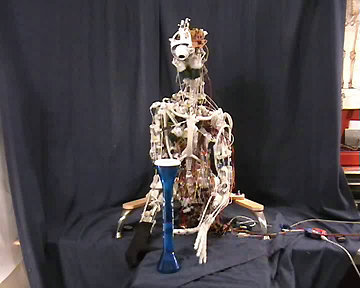Professor Owen Holland
The Wired article Experimental AI Powers Robot Army said
“Owen Holland, a researcher at the University of Essex who is building an ‘ultraswarm’ of miniature Bluetooth-connected helicopters, said neural networks can be very effective for dealing with changing circumstances: ‘If you rip a leg off, they’ll work out what’s happened, and re-evolve a different gait that works.’Still, he admitted the swarm approach has its limits. ‘The fundamental problem with the swarm intelligence approach is that we cannot usually go from a knowledge of what we want the system to do to a knowledge of the simple rules that will automatically produce the desired result when loaded onto the robots,’ he said. ‘I can’t see us ever being able to do more than repeat the process using artificial evolution or some other open-ended search technique.’”
Professor Owen Holland a professor of computer science and Deputy Head of the Research Department at the University of Essex in the UK. Previously, he has held faculty positions at Caltech, University of Bielefeld, Starlab and the University of the West of England.
Holland is most famous for his work in biologically-inspired robotics, where he has contributed to the theory and practice of collective robotics, ant algorithms and machine consciousness, among other sub-fields. Some of the projects he has been involved in has attracted a good deal of attention from the media, notably the Slugbot project, which aimed to produce a robotic predator capable of sustaining its energy levels from hunting and digesting snails.
 He is Principal Investigator of the EPSRC Adventure Fund project
Machine consciousness through internal modeling.
He is a Co-investigator for the EPSRC public engagement project
Walking with Robots.
He is Principal Investigator of the EPSRC Adventure Fund project
Machine consciousness through internal modeling.
He is a Co-investigator for the EPSRC public engagement project
Walking with Robots.
Owen is also exploring ways of getting a group of small aircraft to fly like a flock of birds, while at the same time performing non-trivial task-related distributed computation across a wireless network. The UltraSwarm is the indoor version; the initial development used Proxflyer miniature helicopters. The construction of the first prototype UltraSwarm node has been successfully completed — it is fitted with a Gumstix miniature Linux computer and a Bluetooth module, and is currently the smallest flying web server in the world — in the picture it is serving up the project web page over the Bluetooth link! He’s now evaluating a new aerial platform — the Hirobo Lama XRB SR. When the flock has been completed, the Bluetooth modules will be configured as a single Piconet with the master on the arena-based computer system. Like the prototype, each helicopter will also carry a stripped-down color video camera (a spycam) which will be used both for flight control, and for gathering data for a cooperative visual task. The background of this project is described in a paper presented at the IEEE Swarm Intelligence Symposium in June 2005. Read SwarMAV: A Swarm of Miniature Aerial Vehicles for the latest information on this project.
He coauthored Artificial Ethology, The application of wireless local area network technology to the control of mobile robots, On Meme-Gene Coevolution, Stigmergy, Self-organization, and Sorting in Collective Robotics, Towards Robot Autonomy in the Natural World: A Robot in Predator’s Clothing, Reaction-diffusion and ant-based load balancing of communication networks, and Robots With Internal Models: A Route to Machine Consciousness?, and edited Machine Consciousness. Read a full list of his publications!
 Watch a test of a shoulder-blade-equipped left arm on one of his
robots
as part of his
CRONOS Project.
Listen to him on a
“Talking Robots” podcast.
Watch a test of a shoulder-blade-equipped left arm on one of his
robots
as part of his
CRONOS Project.
Listen to him on a
“Talking Robots” podcast.
